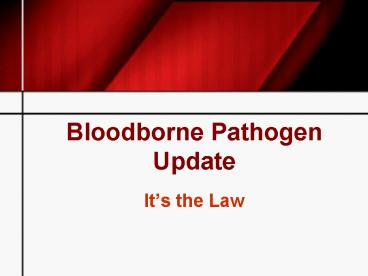Bloodborne Pathogen Update - PowerPoint PPT Presentation
1 / 21
Title: Bloodborne Pathogen Update
1
Bloodborne Pathogen Update
- Its the Law
2
1991 OSHA BBP Standard
- Written exposure control plan
- Free hepatitis B vaccine
- Engineering controls
- Labeling/color coding
- Training
3
The BBP Standard 2001
- Mandatory safe needle and sharp devices
- If the safe needle/sharp cannot be used
clinically, there must be documentation
4
What is the Big Deal?
- CDC is aware of 57 healthcare workers in the U.S.
who have been documented as having seroconverted
to HIV following occupational exposures.
- 24 nurses
- 19 laboratory workers
- 6 physicians
- 2 surgical technicians
- 1 dialysis technician
- 1 respiratory therapist
- 1 health aide
- 1 morgue technician
- 2 housekeepers
5
What about Vandy?
- One of the 6 physicians who converted, converted
at VUMC - The risk is very real
6
Protecting You from Exposure
- Standard Precautions is the single most important
measure to control transmission of bloodborne
pathogens. - Standard Precautions means to treat ALL human
blood and other potentially infectious materials
as if they were infected with bloodborne
pathogens.
7
Protecting You from Exposure
Written Exposure Control Plan
- VUMC Policy OP 20-25
8
Work Practice Controls
Do not mouth pipette or suction blood or other
potentially infectious materials.
Do not eat, drink or apply cosmetics in clinical
areas.
9
Hand Hygiene
- To protect yourself and our very sick patients,
WASH YOUR HANDS! - You can use alcohol gel or soap and water
10
Do Not Wear..
- Sandals if you provide direct patient care
- Visible body piercings other than ears
- Refer to policies
- CL20-06.05
- OP 20-06.20
- OP 10-60
11
Personal Protective Equipment
Personal protective equipment (PPE) is available
to you to reduce your risk of exposure. The PPE
includes
- Masks
- Gloves
- Goggles
- Mask/goggle combo
- Shoe covers
- Gowns
12
Handling of PPE
- Remove PPE prior to leaving the work area
- OR shoes covers, masks, or any other PPE should
NOT be worn outside the work area - Contaminated PPE should be disposed of in red
bags. - uncontaminated PPE can be disposed of in the
regular trash
13
Signs and Labels
- Red bagsInfectious Waste
- Biohazard symbol
- Yellow linen bag contaminated linen (all dirty
linen treated as if infectious)
14
What if I find a blood spill?
- Get something to blot the blood, like paper
towels. - Notify Environmental Services that a blood spill
has occurred and tell them the location
15
How to Clean a Blood Spill
- Don gloves
- Blot spill with absorbent material
- Discard blood soaked material in a red bag
- Disinfect with hospital approved disinfectant
- Remove gloves and discard in red bag
- Wash Hands
16
If An Exposure Occurs
- Immediate first aid
- Wash needlesticks and cuts with soap and water
- Flush splashes to the nose, mouth, or skin with
water - Irrigate eyes with clean water, saline, or
sterile irrigants.
17
If An Exposure Occurs
- Following any blood/body fluid exposure, you
should report the exposure by - Completing a Tennessee First Report of Work
Injury - Promptly reporting to Occupational Health Clinic
or the VUMC ED
18
Post Exposure Documentation
- Type and Brand of device causing injury BD
syringe - Place where injury occurred 8N Rm 8010 or 4140
MRB3 - Explanation of the incident I laid the syringe
on the table.. - Route of exposure needlestick or splash to
face, etc - Work practices and personal protective equipment
being used at the time of the incident gloves
only, no mask
19
In the interest of patient, staff, faculty
student safety
- Refrain from placing medical equipment/ devices
on mattresses.
Dont leave sharps on the patients bed.
Never stick needles/ sharps into the mattress.
20
Sharp objects in the patient bed jeopardize
employee and patient safety by
- Causing blood and body fluid exposures from
needles/sharps injuries. - Damaging theintegrity of themattresscovers
andmattressescausingcontaminationfrom blood
andbody fluids.
Place protective covers on sharp ends of external
fixation hardware.
21
If you have questions
- Call Infection Control at X-60725 24/7 beepers
- Call Vanderbilt Environmental Health and Safety
at X-22057 - Call Occupational Health at X-60955































